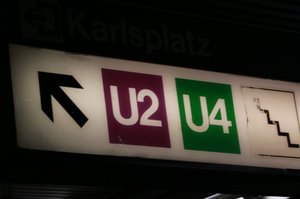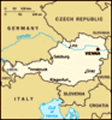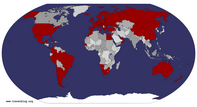Advertisement
Published: June 26th 2017

 The famous U2 line...
The famous U2 line...
..and I've still not found what I am looking for!!!Due to a busy day yesterday we decided to take it easy today. After a late breakfast we had agreed to head out to Schönbrunn Palace. We were told the U-2 would take us to this chateau that is on par with such classic chateaux as Versailles or Fontainebleau. However, after studying our route, if we had have taken the U2 we still wouldn't find what we were looking for!!!
Schönbrunn Palace is situated about 5 miles east of Vienna city centre. The most direct and quickest way to the Palace is by U-bahn but not the U2. The U4 would take us direct to the station of the same name and from there it is less than a five minute walk to the Palace gates. However, the nearest u-bahn to our hotel, Stadtpark, was closed for renovation in the direction we wanted to travel so we walked 500m or so in the opposite direction, past Karlskirke and picked up the trail at Karlsplatz u-bahn station.
Despite being known as the Underground, a subway, metro, whatever you want to call it, similar to the London Underground, there are a number of over ground stations on the u-bahn network. The
biggest surprise was that when the train on which we were travelling hit 'daylight' we were greeted by a thick covering of white on the ground, roof tops, parked cars. Somehow in the few miles we had travelled, two inches of snow had fallen. This was totally unexpected but certainly not unwelcome!
The intricate cast iron gates to the entrance to Schönbrunn Palace were dwarfed by two columns, towering 50 feet either side of the gates topped with gold eagles spreading out their wings.
The Palace has over 1,400 rooms. If we were to visit ever room for just 5 minutes it would take nearly 2 weeks to complete our tour. I'm not sure I could stretch the blog out that long!! Furthermore, entrance to this magnificent example of a baroque style palace costs €21. That's a fraction over 1½ pence per room. Now that's what I call value for money!! It would have been even cheaper with the Vienna card at only €17.20 for a two week tour of the Hapsburg summer residence!
We walked through park land following the outside of the Palace through the orangery garden, where as we were in the middle of
winter was not looking at its orangiest!! The centre-piece of the orangery garden, a small pond was frozen solid. We passed the maze and soon reached the back of the building. Not so much of a back yard but, at an area of 1.2 square kilometres, more of a park!! The sculptured gardens were designed by a Frenchman called Jean Trehet. He got the gig because he went to school with the bloke who designed the gardens at Versailles!!! Today we were unable to appreciate the intricate pattern of what is known as the French Garden due to the blanket of white that enveloped the grounds. At one end of the park, the palace and at the other end, perched on a small tor, a building known as the Gloriette, named after a French word meaning
little room. This structure was built to serve as both a focal point and a lookout point for the garden. It was used as a dining hall and festival hall as well as a breakfast room for Emperor Franz Joseph I. In front of the Gloriette stood at the bottom of the 50m high hill lies a sculpture known as the Neptune fountain. From
a projecting semi-oval plinth, a rocky formation emerges with the sea-god Neptune and his entourage. This work of art was commissioned in 1776 by the then Empress Marie Theresa. This image of Neptune commanding the watery dominion was a common symbol in the eighteenth-century, to represent monarchs controlling the fate of their people.
After refueling on coffee and cake we took the u-bahn to a station called Praterstern in the Viennese district of Leopoldstadt, the home of Johann Strauss I and II. However, we weren't on the hunt for the Strauss house. Crossing the roundabout on which the u-bahn was situated we headed down Ausstellungstrasse and in to the Prater, a public park that houses an iconic Ferris wheel. It is the centre piece of an amusement park called the Wurstelprater, Unfortunately being the middle of January, whilst you could still walk around, all the rides were closed. Ironically there was nothing ‘amusing' about this park!!
The Ferris wheel sybolises the district as well as the city for many people. It is a bit of a celebrity in these parts having featured in the films
The Third Man and Bond's
The Living Daylights!! Built in 1897, the
Reisenrad was the tallest Ferris wheel, standing at 64.75m (212ft), until 1985. Now it's the 31
st tallest wheel. By comparison, the London Eye is 135m (443ft) high and the tallest Ferris wheel based in Las Vegas is known as the High Roller and stands at a colossal 167m (550ft). As well as the Ferris Wheel we also passed the bumper cars, a carousel, a rickety roller coaster and a ghost train. The Wurstelprater was paved with so many nostalgic memories I felt like I'd walked in to a fair ground of my childhood. Looking at the age of these attractions I was now starting to doubt that these rides were closed but rather closed down!!! This is why the likes of Disney Land, Six Flags and Alton Towers are so successful. They don't contain any of the above!!! Near the entrance to the amusement park is a statue of the parks founder Basilio Calafati who was born at the turn of the 19
th century. He was renowned for being a magician, restaurant owner and all round showman.
The Danube River does not run through the centre of Vienna. The banks of Europe's second longest river lie approximately two miles outside
the inner ring road. As luck would have it, our excursion so far had taken us within a stone's throw. Although our stroll was only just over half a mile it seemed to take forever. The walk was uninspiring, continuing on down Austellungstrasse then cutting through a housing estate and over a footbridge and there she was. 450 miles from the source, 1,335 miles to go until the Danube empties in to the Black Sea.
On the way back, Austellungstrasse seemed much busier. The crowds were emanating from a large flat roofed building. Furthermore, on the concourse that surrounded this building, vendors were selling helium filled balloons of odd looking animals whilst the wurst vendors were doing their worst!! Families were heading in to the u-bahn, groups of males and females, both young and old lined the platforms. What they all had in common was that they all carried carrier bags, most displaying the logo of BMW, Toyota, Audi and other such car marques. I learned later that we had passed the Messe Wien or the Trade Centre. The Messe is an exhibition Centre where the Auto show 2017 was in progress. I should have guessed as the clue
was in the name of the road;
Ausstellung means exhibition in German!! The Messe is famous (in Austria, anyway!!) for almost hosting the 2015 Eurovision Song Contest after Austria's Conchita Wurst's victory the previous year. Unfortunately the Messe Wien lost out to the Wiener Stadthalle, a multi-purpose indoor arena and convention Centre!!
A visit wouldn't be complete to Vienna without seeing the magnificent gothic structure that is Stephansdom, St Stephen's cathedral. Although the first structure was completed in 1160, the building went through major reconstruction and renovation and the building as we see it today dates back to 1510. The cathedral is dominated by two massive towers. The south tower stands 165m and is the tallest point of the Vienna skyline. The north tower should have mirrored the south tower but as it was constructed at a later time when the gothic period was coming to an end, the project proved too ambitious. What I'm trying to say is as the gothic stonemasons retired there was no transfer of skills to their younger counterparts. The recruitment exercise must have been too late and the craft of gothic stone masonry was soon forgotten. This wasn't the case though for the
tilers. In those days tilers weren't just glorified roofers who had a piece of paper saying they were qualified. Oh no! Tilers in the 16
th century were artists. This is demonstrated by the double-eagle imperial emblem with the Habsburg-Lorraine coat of arms on its chest on the main roof of the cathedral constructed from coloured tiles.
So that's how our short break to Vienna ended: me looking at the mosaic tiles on the top of a church (albeit a BIG church!) thinking how cool it would be to get coloured roof tiles from B & Q to create the LFC club badge on the roof of
our humble abode!! As capital cities go, Vienna ticks all the boxes. It's got its fair share of historic buildings but a massive plus it that all this fantastic architecture is contained within the Innere Stadt making everything pretty much within walking distance. There are plenty of eateries whether you prefer traditional Austrian cuisine or prefer a more international flavour such as Pizza Hut (Italy), Walkabout (Australia) or McDonalds (USA), Vienna has them all!!! The cost of living doesn't seem to be as extortionate as other capitals such as London or Paris
and public transport is, to be expected, very efficient.
To quote Frederic Chopin, ‘
Vienna is a handsome, lively city, and pleases me exceedingly. (Come to think of it, it may have been Mr. Kipling!!) He (Chopin not Mr. Kipling!!) knew what he was talking about (and he could knock out a good tune or two on the ‘ol ivory keys!!) But then again Chopin was Polish, and lived in Warsaw. If you've ever been to Warsaw you'll know that anywhere is a step up from Poland's premier city!!
Joking aside my feeling for this city can be summed up by quoting one of the most famous Austrians of all time: ‘
I'll be back!!!'
Advertisement
Tot: 0.384s; Tpl: 0.016s; cc: 11; qc: 56; dbt: 0.1065s; 1; m:domysql w:travelblog (10.17.0.13); sld: 1;
; mem: 1.3mb




















